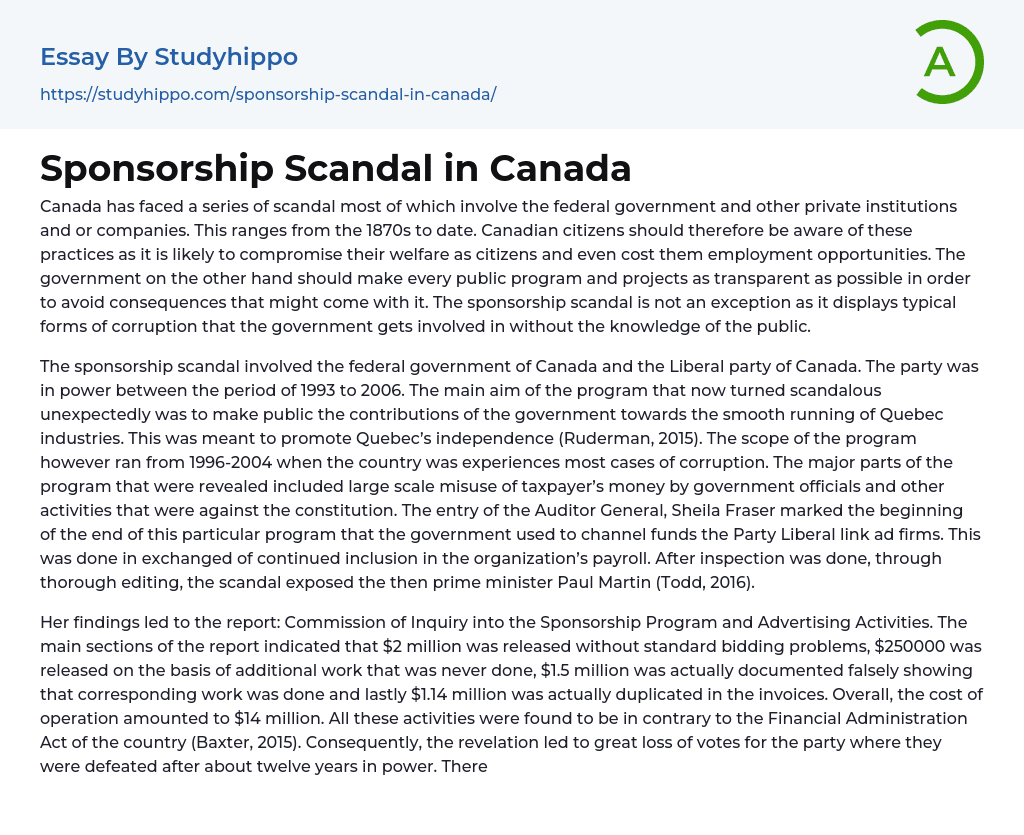Canada has faced a series of scandal most of which involve the federal government and other private institutions and or companies. This ranges from the 1870s to date. Canadian citizens should therefore be aware of these practices as it is likely to compromise their welfare as citizens and even cost them employment opportunities. The government on the other hand should make every public program and projects as transparent as possible in order to avoid consequences that might come with it. The sponsorship scandal is not an exception as it displays typical forms of corruption that the government gets involved in without the knowledge of the public.
The sponsorship scandal involved the federal government of Canada and the Liberal party of Canada. The party was in power between the period of 1993 to 2006. The main aim of the program that now turned scandalous unexp
...ectedly was to make public the contributions of the government towards the smooth running of Quebec industries. This was meant to promote Quebec’s independence (Ruderman, 2015). The scope of the program however ran from 1996-2004 when the country was experiences most cases of corruption. The major parts of the program that were revealed included large scale misuse of taxpayer’s money by government officials and other activities that were against the constitution. The entry of the Auditor General, Sheila Fraser marked the beginning of the end of this particular program that the government used to channel funds the Party Liberal link ad firms. This was done in exchanged of continued inclusion in the organization’s payroll. After inspection was done, through thorough editing, the scandal exposed the then prime minister Paul Martin (Todd, 2016).
Her findings
led to the report: Commission of Inquiry into the Sponsorship Program and Advertising Activities. The main sections of the report indicated that $2 million was released without standard bidding problems, $250000 was released on the basis of additional work that was never done, $1.5 million was actually documented falsely showing that corresponding work was done and lastly $1.14 million was actually duplicated in the invoices. Overall, the cost of operation amounted to $14 million. All these activities were found to be in contrary to the Financial Administration Act of the country (Baxter, 2015). Consequently, the revelation led to great loss of votes for the party where they were defeated after about twelve years in power. Therefore, in 2006, the people elected another government that consisted of officials that could be trusted. This means that Canadians did not like the corruption cases that surrounded their president. The sponsorship program therefore faced closure the audit.
It is important the Canadian citizens know about the budget of the government and how the public funds are utilized. The sponsorship program for example used a lot of public funds that would have been otherwise used in other productive projects. Therefore, every citizen has the right to inquire and question the actions of the government. They actually express their feelings and takes during federal elections. If it doesn’t involve those that hold elective positions, then they have all the rights to demand their removal from office.
Conclusion
In conclusion, several scandals occur within and outside the government. They actually lower the trust that citizens have for their government. It is for this reason that some officials fail to be elected a second time. The
sponsorship scandal is a clear indication of how public funds can sometimes be misused instead of funding beneficial projects that would ensure an increase in welfare or rather per capita income.
References
- Ruderman, N., & Nevitte, N. (2015). Assessing the Impact of Political Scandals on Attitudes toward Democracy: Evidence from Canada's Sponsorship Scandal. Canadian Journal of Political Science, 48(04), 885-904.
- Todd, R. (2016). Towards Constructive Change in Aboriginal Communities: A Social Psychology Perspective by Donald M. Taylor and Roxane de la Sablonnière (review). British Journal of Canadian Studies, 29(2), 289-290.
- Baxter, J. (2015). From Integrity Agency to Accountability Network: The Political Economy of Public Sector Oversight in Canada. Ottawa Law Review, 46(2).
- Alaska essays
- Boston essays
- Brazil essays
- California essays
- Canada essays
- Chicago essays
- Costa Rica essays
- Florida essays
- Hawaii essays
- Latin America essays
- Los Angeles essays
- Mexico essays
- Slavery In America essays
- Usa essays
- Virginia essays
- Washington essays
- Addiction essays
- Anatomy and Physiology essays
- Biodegradation essays
- Cancer essays
- Dental Care essays
- Disability essays
- Disease essays
- Disorders essays
- Health Care essays
- Infectious Disease essays
- Inquiry essays
- Intelligence Quotient essays
- Lung Cancer essays
- Medicine essays
- Neurology essays
- Nutrition essays
- Olfaction essays
- Physical Exercise essays
- Public Health essays
- Sex essays
- Women's Health essays
- World health organization essays




